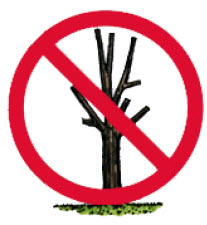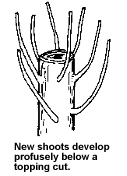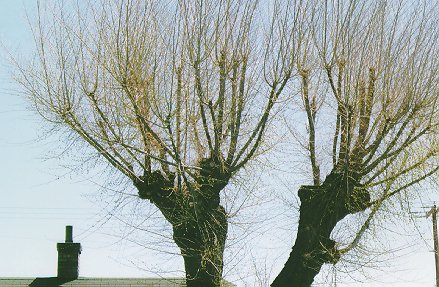Why Topping Hurts Trees
Topping a tree is perhaps the most harmful pruning practice known. Yet, despite
many years of literature and seminars explaining its harmful effects, topping remains a common practice.
Topping is not an acceptable pruning technique.
The most common reason given for topping is to reduce the size of a tree. Home owners often feel that their trees have become too large for their property. People fear that tall trees may pose a hazard. Topping, however, is not a viable method of height reduction and certainly does not reduce the hazard. In fact, topping will make a tree more hazardous in the long term.
Six Reasons Why Trees Should Not Be Topped
1. Topping Stresses Trees

Topping
often removes 50 to 100 percent of the leaf-bearing crown of a tree.
Because leaves are the food factories of a tree, removing them can
temporarily starve a tree.
The severity of the pruning triggers a sort of survival mechanism -
it forces the rapid growth of multiple shoots below each cut to put
out a new crop of leaves as soon as possible. If a tree does not
have the stored energy reserves to do so, it will be seriously
weakened and may die.
A stressed tree is more vulnerable to insect and disease
infestations. Large, open pruning wounds expose the sapwood and
heartwood to attacks. The tree may lack sufficient energy to
chemically defend the wounds against invasion, and some insects are
actually attracted to the chemical signals trees release.

2. Topping Causes Decay
Topping cuts create stubs with wounds that the tree may not be able
to close. When this happens, the exposed wood tissues begin to
decay.
3. Topping Can Lead to Sunburn
Believe it or not, tree branches can get sunburned. Branches
within a trees crown produce thousands of leaves to absorb
sunlight. When the leaves are removed, the remaining branches and
trunk are suddenly exposed to high levels of light and heat. The
result may be sunburn of the tissues beneath the bark, which can
lead to bark splitting, cankers and death of some branches.
4. Topping Creates Hazards
The survival mechanism that causes a tree to produce multiple shoots
below each topping cut (see item #1) comes at great expense to the
tree. These shoots are anchored only in the outermost layers of the
parent branches and are therefore very weak and prone to breaking,
especially during windy conditions.

5. Topping Makes Trees Ugly
The natural branching structure of a tree is often the beauty of the
tree. Topping removes the ends of the branches, often leaving
ugly stubs and destroying the natural form of a tree.
Without leaves, a topped tree appears disfigured and mutilated up to
6 months of the year. A tree that has been topped can never fully
regain its natural form.
6. Topping Is Expensive
The cost of topping a tree is not limited to the initial pruning
job. If the tree survives, it will require pruning again
within a few years and often becomes a candidate for storm damage
and may also need to be removed.
Another hidden cost to topping is the reduction in property value.
Healthy, well-maintained trees can add 10-20% percent to the value
of a property. Disfigured, topped trees are considered an impending
expense.
And consider the cost of a topped tree's potential liability. Topped
trees are prone to breaking and can be hazardous. Because topping is
considered an unacceptable pruning practice, any damage caused by
branch failure of a topped tree may lead to a finding of negligence
in a court of law.
Contact one of our arborists to discuss
your trees' needs today.
(Content source: ISA website www.treesaregood.com)
|

